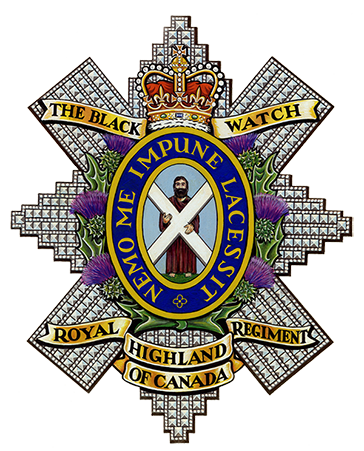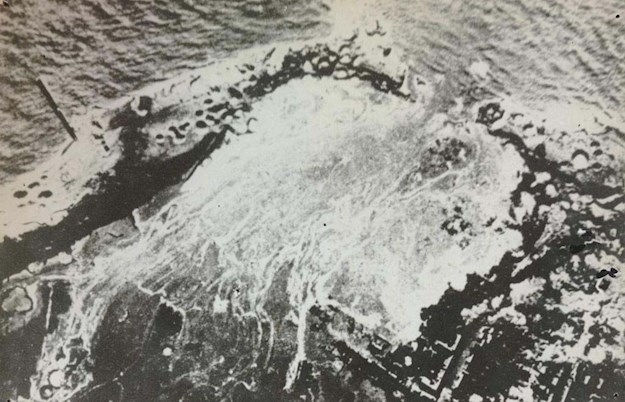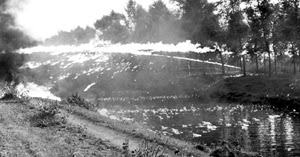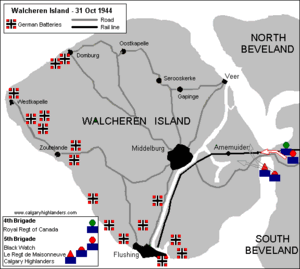Canada's Liberation of the Netherlands Part 2: Open The Flood Gates!
- Samantha Cowan
- Dec 8, 2019
- 5 min read
Did you want to go to our 75th Liberation of the Netherlands Anniversary Tour Page Click Here

The Canadians were now in the final stretch of their mission! The remaining objectives consisted of completely securing South Beveland and knocking out the remaining German defences on Walcheren Island.

The commander of the Canadian troops at the time was Lieutenant-General Guy Simonds, who was more than qualified to lead the troops as he had a number of previous successful missions under his belt. With the success of the 2nd & 3rd infantry division and 4th armoured division's fierce fighting, the Leopold Canal and shores of the Scheldt's was now secured. Guy Simonds would now re-concentrate the remaining divisions for a two-part assault to finally free South Beveland.
The Leopold Canal today and as it was during 1944. The Germans held positions all along the canal and would engage the Canadians with armoured vehicles and flame throwers.
The Germans would fire their "Panzerwerfer Nebelwerfer Wurfrahmen" (rocket launchers) at the Canadians, who would describe the noise as 1000 doors slamming shut continuously.

The first part of Guy Simonds's plan consisted of the 2nd Canadian infantry division to push through South Beveland by foot to capture strategic points such as bridges, roads and train tracks. They were successful but took heavy causalities and were hindered greatly by constant land mines and muddy terrain...
The second part of Guy Simond's plan consisted of a combination of the 52nd lowland division and the 6th infantry division. They would conduct a surprise nighttime amphibious assault from the west and land on the shores behind enemy lines.
LVT (Landing Vehicle Tracked) a.k.a "Buffaloes" used by the Canadians and British Army during the liberation of the Netherlands.
With a successful assault from the water, the Canadian's were able to capture all canals and roads that were previously under German control. With no direct supply routes feeding the enemies, the German defences soon fell and South Beveland was finally under Allied control!
There was one final objective left for the Canadians to capture. In order to have full control of the seaports in Antwerp, the Canadians would have to take over Walcheren Island.....
The Battle of Walcheren Island
1. The Sloedam: A dam/causeway, connecting the Dutch islands Beveland and Walcheren.


On October 31st, "C" Company of Canada's Black Watch regiment moved towards Walcheren Island. As of now the only way to the island was a small narrow dam/causeway connecting Beveland to Walcheren known as the Sloedam. The path was covered in craters made by the Germans to deter any Allied armoured vehicles, forcing the troops to advance by foot. These craters acted as cover for the Canadians and would serve as checkpoints for future pushes on the Sloedam.
Despite their efforts, the task was just too difficult due to the circumstances of the narrowness of the causeway. The Black Watch regiment were open targets for German machine gunners and would have little to no clear line of sight to where the enemy were positioned. The Germans would mow down any advancements made by the Canadians with ease, forcing an Allie retreat.

"B" Company of Canada's Calgary Highlanders were ordered to try and make it across the Sloedam just after midnight to see if a blanket of darkness would be deemed successful. The Highlanders would only make it halfway across the Sloedam before meeting the same fate as the Black Watch regiment.

The Canadians were now critically low on troops and in dire need of a new plan if they were to complete this mission. Luckily for Canadians, focus on the operation Market Garden was now slowing down as the outcome wasn't as successful as hoped. Therefore if the commanding Generals wanted to keep their jobs and be on good terms with the U.S President, they would now have to direct their troops back to Beveland and bring much-needed aid to the Canadians. ( This is in reference to the infamous letters Montgomery had exchanged with the U.S President at the time and how Montgomery brought Roosevelt's leadership skills into question).
A new plan was now devised and consisted of a triple assault on Walcheren Island. The Royal Air Force and Navy would commence with aerial and naval bombardments of fortified German positions from the West Sea. They would also target dykes and dams resulting in Walcheren Island being flooded, allowing new vantage points for amphibious vehicles.

The Royal Air Force would fly over the town of Westkapelle and drop leaflets to warn all civilians to leave the town as soon as possible without any explanation as to why they had to leave. Although in the end, the Germans held the town and halted any evacuation plans. On the 3rd of October, the town 's nearby dykes were bombed and resulted in 80% of the island to go below sea level, costing 152 civilian lives

British forces as they storm Uncle Beach outside the town of Westkapelle after the area was flooded from the bombardment of nearby dykes and dams.

With help from Dutch resistance forces and local knowledge of low tides, the Canadians were now able to cross the causeway from Beveland to Walcheren. The German defences were now shattered which allowed the Allies to capture the Island's capital, "Middleburg". The Allies were now able to start moving up the canal to make use of the seaports. The 4th Canadian armoured division was able to sink any German vessels that stood in their way to Zijpe harbour. The land leading up to the Maas River was now secured and on November 8th, the battle of the Scheldt had finally come to an end. There were 12,873 casualties (killed, wounded, or missing), 6,367 of whom were Canadians. (Veterans Affairs Canada).
Now that the main seaports were secured and vital supplies and re-enforcements were on their way, the Canadian's would now make their way to Holland with the task of liberating each city along the way.
Commemorate With Us
With the 75th Anniversary of Canada’s Liberation of the Netherlands, let us join together in celebration and thanks for the Canadians who sacrificed so much for us. In their honour, we travel to Normandy and Holland for the 75th Commemorative events. Join us to remember the bravery and vigour of our boys on the battlefields during those fateful days. Embrace the Netherlands that we know and love today, and help us honour the sacrifice endured by keeping our Canadian story alive. If you would like to join us on the upcoming program commemorating the 75th Anniversary of Canadians in Holland, or if you would like more information in regards to the events taking place in France/Holland for the anniversary, Click Here






























Comments